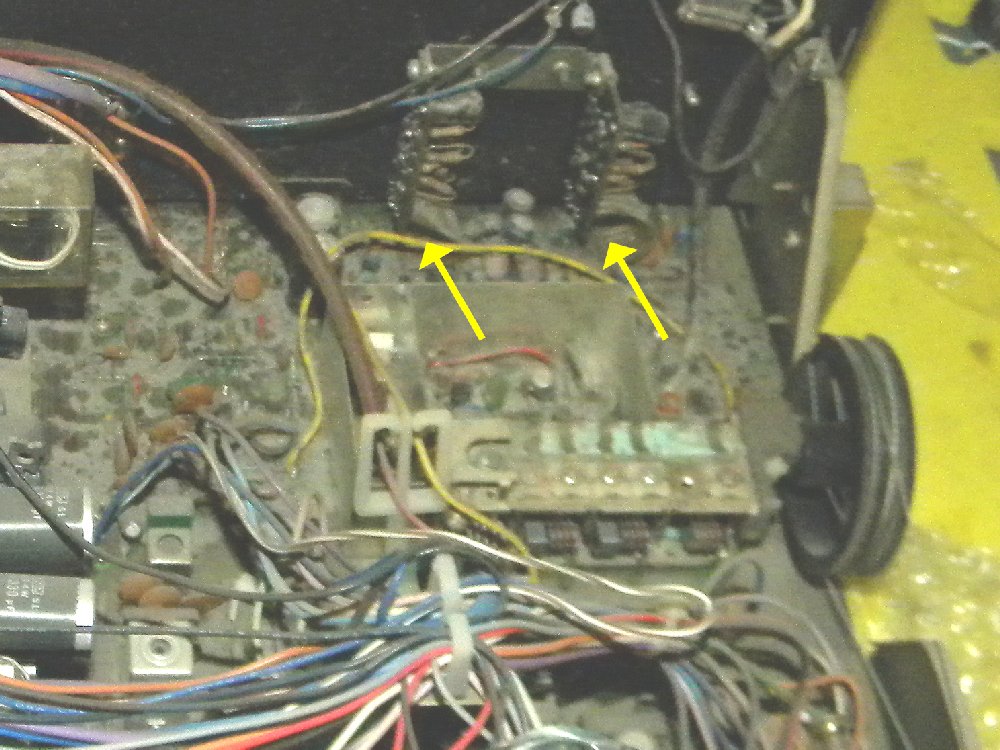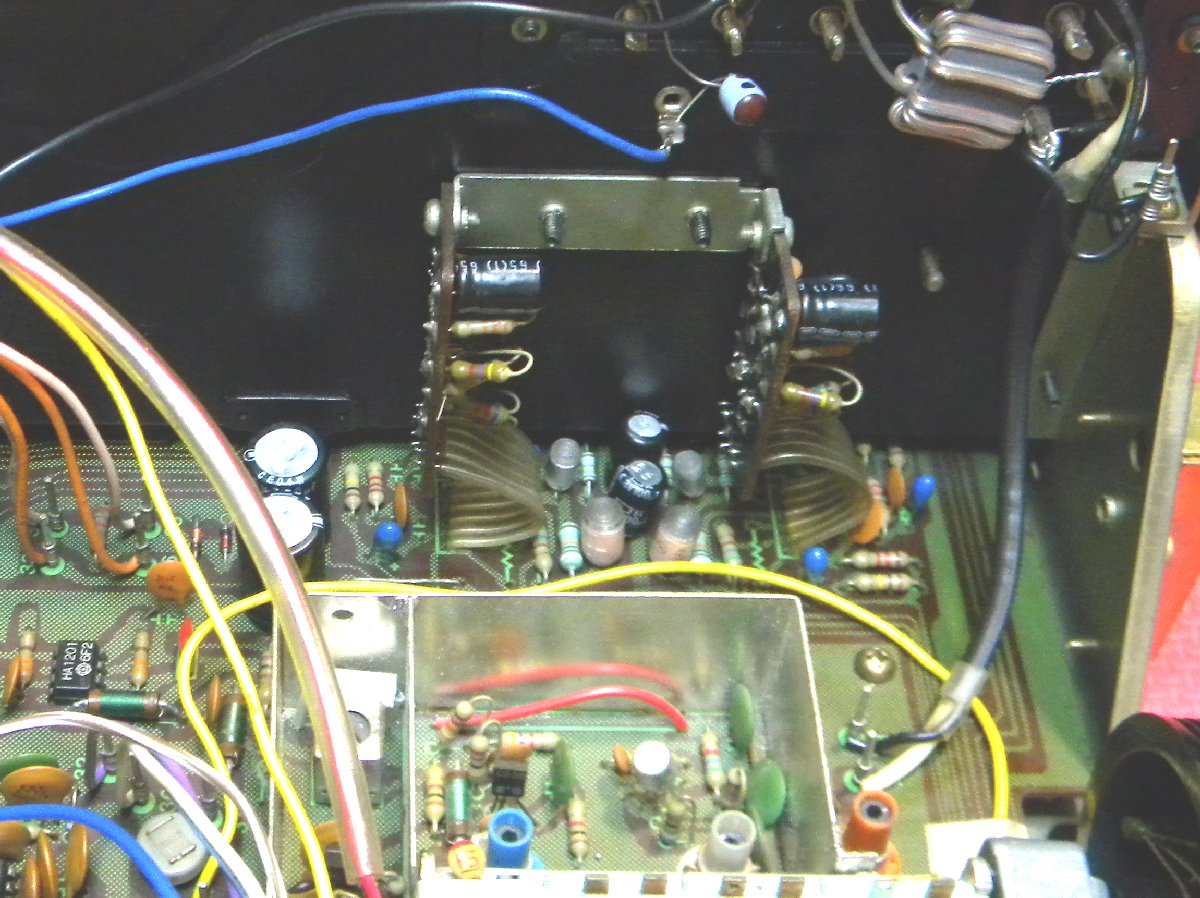You are using an out of date browser. It may not display this or other websites correctly.
You should upgrade or use an alternative browser.
You should upgrade or use an alternative browser.
Wtf?
- Thread starter Watthour
- Start date
I have some ideas, the picture HAS to be better to make it fair, but that is RIGHT in the middle of the phono amplifier area, what's ON those boards, just transistors, or are there chips?
Looks like multiple connections back to the main board in a row, and that lines up with the TA7136 connections.
AWK-065 boards, the individual phono amps used in the sx-650.
That's my bet and I'm sticking with it.
2x 2sa725, 1x 2sa726, 1x 2sc1313, 100uf 10v cap, OP-amp replacement/implementation, uses equalization on the main board.
5 active wires.
edit: larry and bobhelms solved it YESTERDAY, at 6 am, before you posted it; http://www.audiokarma.org/forums/showpost.php?p=7082322&postcount=9

Looks like multiple connections back to the main board in a row, and that lines up with the TA7136 connections.
AWK-065 boards, the individual phono amps used in the sx-650.
That's my bet and I'm sticking with it.
2x 2sa725, 1x 2sa726, 1x 2sc1313, 100uf 10v cap, OP-amp replacement/implementation, uses equalization on the main board.
5 active wires.
edit: larry and bobhelms solved it YESTERDAY, at 6 am, before you posted it; http://www.audiokarma.org/forums/showpost.php?p=7082322&postcount=9
Last edited:
restorer-john
Addicted Member
Look at the schematic in the LOWER LEFT HAND CORNER. The area outlined in RED. The schematic shows the TA7136P, but the note also tells you that the AWK-065 boards were put in.
I'm curious as to the BORN ON DATE on that 750 vs. BobHelms. Can you post the Serial #.
I'm curious as to the BORN ON DATE on that 750 vs. BobHelms. Can you post the Serial #.
Watthour
Electron Rancher - JS3600
BR-549. Or, 867-5309.
Actually, it's WF3605816S, and was born in Japan instead of Korea.
Incidentally, those two little boards are loaded up with 2SA725s and 2SC1313. The only thing they could have done to further complete the trinity would have been to glue on some blasting caps. I'm thinking I might as well just solder in jumper wire in their places and save myself the future frustration (or throw in the appropriate KSAXXXs)
Actually, it's WF3605816S, and was born in Japan instead of Korea.
Incidentally, those two little boards are loaded up with 2SA725s and 2SC1313. The only thing they could have done to further complete the trinity would have been to glue on some blasting caps. I'm thinking I might as well just solder in jumper wire in their places and save myself the future frustration (or throw in the appropriate KSAXXXs)
Watthour
Electron Rancher - JS3600
Of course. This is another DOA unit to be resurrected.
The last "Yellow Submarine" SX-750 is now a screamer. The audio path is now as clean as a surgical theater and the tuner is tweaked up even tighter than my best Kenwood. It can almost pull a signal from Lower Uzbekistan with a ¼" wire screwed to one of the 300Ω FM terminals. Well, that may be an exaggeration, but she's uber-sensitive now on FM, certainly equal to or better than the formidable tuners on my Kennys.
The last "Yellow Submarine" SX-750 is now a screamer. The audio path is now as clean as a surgical theater and the tuner is tweaked up even tighter than my best Kenwood. It can almost pull a signal from Lower Uzbekistan with a ¼" wire screwed to one of the 300Ω FM terminals. Well, that may be an exaggeration, but she's uber-sensitive now on FM, certainly equal to or better than the formidable tuners on my Kennys.
samc777
Active Member
In all their cleaned-up glory:
Wow, what magic unobtainium in California chemical cleaner is used to do that awesome cleaning job?
Dave
Watthour
Electron Rancher - JS3600
Wow, what magic unobtainium in California chemical cleaner is used to do that awesome cleaning job?
I use a proprietary mixture of dihydrogen monoxide and a commercially available concentrated surfactant. The former is preheated in a large, gas-fired pressurized vessel until it reaches an appropriate temperature. It is distributed via a dedicated system of tubing, flow controls, and mixing valves which I have installed just for that purpose. The preheated compound is applied to the circuit board(s) to dilute and soften the contaminants. An preparation of the surfactant is performed by hand using an inert applicator made from the hair of Manchurian oxen. Once applied, the contaminants are encapsulated by the surfactants since the molecular cohesion of the surfactants is greater than the molecular adhesion of the contaminants to the substrate. With the contaminants in suspension, additional dihydrogen monoxide is applied to flush the area. Of course, all of this has to be contained, with the byproducts and waste captured so it can be properly treated for disposal as mandated by the USEPA.
It's little wonder that the Peoples' Republik of Kalifornistan cannot allow such substances to enter their borders. Some of this stuff can be lethal if used improperly.
I'll try to post a diagram if I get a chance, but I've already hacked this thread about enough already.
EDIT: A little late, but...

Last edited:
samc777
Active Member
It's little wonder that the Peoples' Republik of Kalifornistan cannot allow such substances to enter their borders. Some of this stuff can be lethal if used improperly.]/QUOTE]
At least that explains why I cant buy it here...
slpcorner
AudioPhan - On the Cheap
I use a proprietary mixture of dihydrogen monoxide and a commercially available concentrated surfactant. The former is preheated in a large, gas-fired pressurized vessel until it reaches an appropriate temperature. It is distributed via a dedicated system of tubing, flow controls, and mixing valves which I have installed just for that purpose. The preheated compound is applied to the circuit board(s) to dilute and soften the contaminants. An preparation of the surfactant is performed by hand using an inert applicator made from the hair of Manchurian oxen. Once applied, the contaminants are encapsulated by the surfactants since the molecular cohesion of the surfactants is greater than the molecular adhesion of the contaminants to the substrate. With the contaminants in suspension, additional dihydrogen monoxide is applied to flush the area. Of course, all of this has to be contained, with the byproducts and waste captured so it can be properly treated for disposal as mandated by the USEPA.
It's little wonder that the Peoples' Republik of Kalifornistan cannot allow such substances to enter their borders. Some of this stuff can be lethal if used improperly.
I'll try to post a diagram if I get a chance, but I've already hacked this thread about enough already.
Nice..
petehall347
the brandy coffee man
you deserve the T shirt for this ...I use a proprietary mixture of dihydrogen monoxide and a commercially available concentrated surfactant. The former is preheated in a large, gas-fired pressurized vessel until it reaches an appropriate temperature. It is distributed via a dedicated system of tubing, flow controls, and mixing valves which I have installed just for that purpose. The preheated compound is applied to the circuit board(s) to dilute and soften the contaminants. An preparation of the surfactant is performed by hand using an inert applicator made from the hair of Manchurian oxen. Once applied, the contaminants are encapsulated by the surfactants since the molecular cohesion of the surfactants is greater than the molecular adhesion of the contaminants to the substrate. With the contaminants in suspension, additional dihydrogen monoxide is applied to flush the area. Of course, all of this has to be contained, with the byproducts and waste captured so it can be properly treated for disposal as mandated by the USEPA.
It's little wonder that the Peoples' Republik of Kalifornistan cannot allow such substances to enter their borders. Some of this stuff can be lethal if used improperly.
I'll try to post a diagram if I get a chance, but I've already hacked this thread about enough already.

:lmao:
I forgo the pressurized heated vessel and associated plumbing. The quantities and flow rates it delivers can be overwhelming and make recovery for adequate processing a problem. A hand held vessel with specially devised manual actuator/pump mechanism and premixed biodegradable surfactant is applied, and a second identical assembly that omits the surfactant is employed. With the lower volumes involved, natural distillation methods separate the dihydrogen monoxide from the surfactant and contaminants, which are then returned to their proper places in the environment.
I forgo the pressurized heated vessel and associated plumbing. The quantities and flow rates it delivers can be overwhelming and make recovery for adequate processing a problem. A hand held vessel with specially devised manual actuator/pump mechanism and premixed biodegradable surfactant is applied, and a second identical assembly that omits the surfactant is employed. With the lower volumes involved, natural distillation methods separate the dihydrogen monoxide from the surfactant and contaminants, which are then returned to their proper places in the environment.
This is one way to clean receiver. Not for the faint of heart. I UNPLUG from WALL and Place the cord in a GALLON SIZE BAGGIE and TAPE CLOSED! Discharge the Main Caps with a 10ohm 5W resistor to ground until DC VTVM or DMM shows ZERO VOLTAGE!!!!. Remove the knobs and front panel for separate cleaning. THEN.........................
Use Scrubbing bubbles for the shower, a brush with medium stiff bristles, Rinse with HOT water(as little as possible) from a spray bottle, then flush with 91% Isopropyl alcohol. Be generous with the alcohol. Blow dry with compressed air, then set on a no longer used for cooking, cookie sheet in the oven for 2-3 hours @ 170*(or lowest setting on oven, unit on the middle rack, UPSIDE DOWN so the wire access holes in the transformer are facing up. Remove and let cool overnight. CRC QD NON RESIDUE ELECTRONICS Cleaner liberally on the variable tuning cap, flush well!!. Let dry for 1 hour.
1st power up on DBT! If OK on the DBT, then wall power.
Dilute Simple Green, or similar can be used in place of the scrubbing bubbles. If there is a lot of dust get in there with the brush and a vacuum cleaner crevice tool 1st.
Larry
Use Scrubbing bubbles for the shower, a brush with medium stiff bristles, Rinse with HOT water(as little as possible) from a spray bottle, then flush with 91% Isopropyl alcohol. Be generous with the alcohol. Blow dry with compressed air, then set on a no longer used for cooking, cookie sheet in the oven for 2-3 hours @ 170*(or lowest setting on oven, unit on the middle rack, UPSIDE DOWN so the wire access holes in the transformer are facing up. Remove and let cool overnight. CRC QD NON RESIDUE ELECTRONICS Cleaner liberally on the variable tuning cap, flush well!!. Let dry for 1 hour.
1st power up on DBT! If OK on the DBT, then wall power.
Dilute Simple Green, or similar can be used in place of the scrubbing bubbles. If there is a lot of dust get in there with the brush and a vacuum cleaner crevice tool 1st.
Larry





